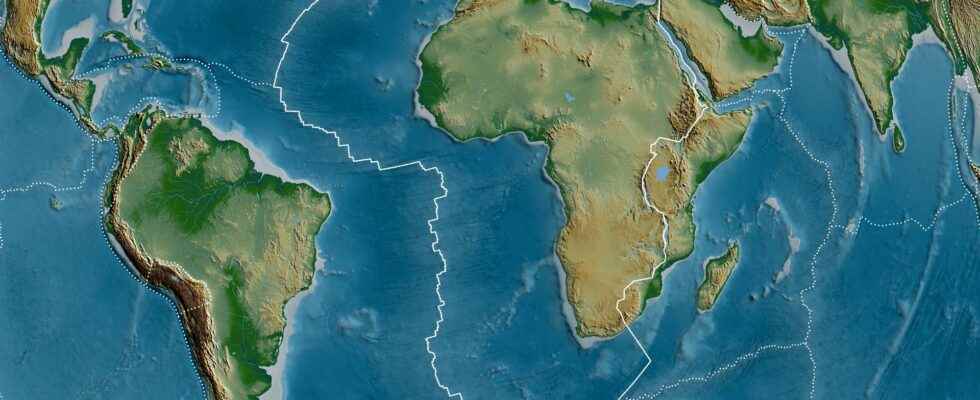In the Pacific, the route of the Hawaii-Emperor volcanic chain has long been used as an indisputable witness to the movement of tectonic plates. However, it shows that a major change occurred 50 million years ago. A new study refines our understanding of the causes of this sudden change in direction of the Pacific plate.
You will also be interested
[EN VIDÉO] A billion years summarized in 40 seconds: plate tectonics Researchers have modeled the movements of tectonic plates over the past billion years.
Among the markers of movement of tectonic platesthe volcanoes hotspots are among the most visible structures on the earth’s surface. Considered fixed, the plume rising through the terrestrial mantle indeed puts its mark on the lithospheric plate passing above it, leading to the creation of long chains of volcanoes and thereby recording the direction of the plate over millions of years.
The best known chain is certainly that of Hawaii-Emperor. 5,700 km long, this chain is made up of more than 80 volcanoes, most of which are submarine. It stretches from the Aleutian Trough in the northwest corner of the Pacific, to the Hawaiian Islandswhich represent the youngest part of the chain.
A sharp change in direction recorded in the path of the chain of volcanoes
The Hawaii-Emperor chain is clearly visible on bathymetric charts of the Pacific, like a long string, created by the shifting of the Pacific oceanic plate over the hotspot, which is currently at the southern end, at Lōʻihi seamount. But what is immediately striking is the bend formed by the chain roughly in the middle.
This change in the course of the volcanic chain has long been interpreted as evidence of a major change in direction of the Pacific plate. The dating of the lavas of the volcanoes located at the level of this bend made it possible to estimate the age of the change of direction at around 47-50 million years. the movement of the plate, hitherto dominant north, would thus have suddenly changed for a direction towards the northwest.
However, the paleomagnetic measurements carried out on the various volcanoes also show that the hot spot, usually thought to be fixed, would have moved south between 80 and 50 million years ago. It now seems likely that these two phenomena acted together to create the pattern we observe today. However, the impact of each of these processes is still poorly constrained. In particular, scientists do not yet clearly understand the cause of the change in direction of the Pacific plate.
The difficult game of cinematic reconstruction
This last point has also been the subject of several hypotheses. It could be associated with the joint initiation, 50 Ma ago, of the Izu-Bonin-Mariannes and Tonga-Kermadec subduction zones. These two subduction zones have indeed developed on the western edge of the Pacific plate, dragging the oceanic plate in this direction.
Another hypothesis involves a global reorganization of tectonic plates at the junction between the ridge separating the Izanagi and Pacific plates with the old subduction zone bordering the eastern margin of Asia. This tectonic event which occurred 60 to 50 Ma ago would have generated a chain reaction tectonic events. India’s collision with Asia, generating a reduction in speed of the subduction of the Indian plate, indeed coincides with the change of direction of the Pacific plate. But how these different tectonic events are related is however unclear.
Multiple factors
Researchers have therefore set about numerically modeling the evolution of the movement of the Pacific plate in response to these different hypotheses. The kinematic plate reconstruction model, published in Nature Geoscienceshows that the entry into subduction of the Izanagi plate, followed by the disappearance of the Izanagi-Pacific ridge and the initiation of the Izu-Bonin-Marianas subduction is not enough to explain the sudden change in plate motion Peaceful.
The authors evoke the participation of another tectonic event. Their hypothesis is that the traction generated by the intra-oceanic subduction of Kronotsky, in the northern part of the Pacific, would have initially pulled the plate towards the north, in agreement with the course of the first part of the Hawaii-Emperor range. . The disappearance, around 50 million years ago, of this subduction and of the traction it exerted would thus have generated a sudden change in the organization of the stresses applied to the Pacific plate, the movement of which would thus have shifted by 30 -35° to the west. But the model shows that this hypothesis does not fully explain the morphology bend in the volcanic chain.
The authors thus suggest that the southward movement of the hot spot would have influenced the course of the chain at that time in an equivalent way. This new scenario shows the complexity of the interactions between the different tectonic and volcanic processes. It also makes it possible to satisfy all the global tectonic constraints, as well as the paleomagnetic data and the geodynamic models of the mantle.
Interested in what you just read?
